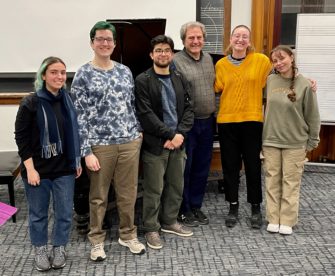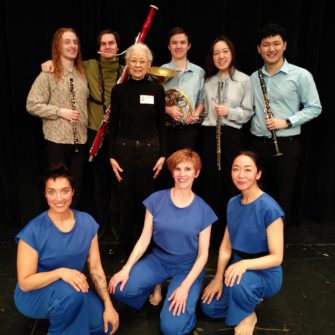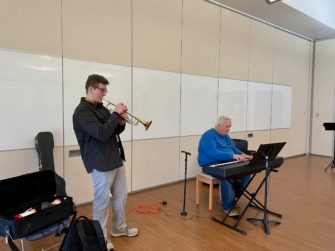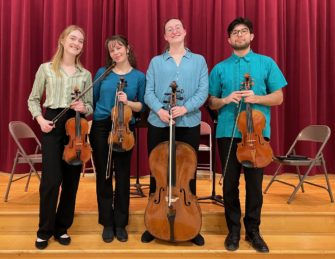Story and photography (unless otherwise noted) by Dr. Sylvie Beaudette, Assistant Professor of Chamber Music and Director of the Eastman To Go community engagement program
Pictured: The A710 Woodwind Quintet performing for students at Wayne Elementary School.

From L to R: Niyayesh Bagheri (composition), Wesley Benjamin (Jazz & Contemporary Media), Juan Alvarez Jimenez (viola), Eric Booth, Anika Grieve (cello), and Veronica Rokicki (violin).
Despite their busy and demanding schedule, intrepid students joined this Spring’s Eastman To Go program to learn the ins and outs of community engagement. At the beginning of the semester, we welcomed three guest presenters: Alden Snell (Associate Professor of Music Teaching and Learning at Eastman) who introduced students to the National Standards for K-12 music curriculum, Wade Richards (Spectrum Creative Arts) who shared his experience with sensory-friendly performances, and Eric Booth who worked with students using the inspiring and mind-blowing Teaching Artist approach.
Each chamber group was assigned three venues representing different audiences: elementary and high schools, as well as community venues. Students then met with me to brainstorm ideas for themes, entry points, and ways of engaging those various audiences with the music they intended to perform. I attended all their performances as well as some rehearsals. The following stories are snapshots of what I observed from the audience’s point of view.

Woodwind Quintet with Daystar Dance members. Back row, from L to R: Sam Suchta, Alistair Picken, Rosalie Jones, Kevin Jin, Hannah Wang, and Sam Wood. Front row, from L to R: Angela Lopez, Nanko Horikawa Mandrino, and Nancy Hughes. Photo credit: Jennifer Button
The A710 Woodwind Quintet had the opportunity to work with Daystar Dance, a Rochester-based company that creates choreographies based on Native-American stories, legends, rituals, dances, and symbols. For this collaboration, A710 learned Indio Ritmo by Native-American composer Louis Ballard. Preparing Ballard’s piece and rehearsing with dancers were unique experiences for these first-year students. Rosalie Jones, Daystar Dance founder and choreographer, discussed with them the symbolism behind the shawl dance (metamorphosis), clowning in the Native-American tradition (laughing as a form of prayer), and the hoop dance (circle of life), all of which inspired her three choreographies. At the Wayne Elementary School in Ontario, NY, children laughed out loud when hearing Indio Ritmo’s second movement which involves two masked clowns playing tricks on each other and running into the audience.
A710 also included two other pieces in their program: an arrangement of Gershwin’s I’ve Got Rhythm and Umoja by Valerie Coleman. With the Ballard piece, the program was curated to show various facets of American music. During the Coleman piece, a Wayne Elementary student wearing noise-cancelling headphones was conducting along with the music but only when the French horn came in!
In its Eastman To Go program — which featured music by Barat and Ewazen — a trumpet and piano duo included music from Iran (the pianist’s country of origin) played on the tanbur, a Persian string instrument. The pianist introduced the tanbur and told audiences that playing it made her feel at home again. She asked audiences to think about what reminds them of home while she performed. At the end of the duo’s performance at Crane Elementary School, students walked in front of the musicians to get a closer look at the various instruments before going back to their classroom. One of the students, a little girl, told the pianist: “I too come from Iran.”

Jazz major Wesley Benjamin plays an impromptu Autumn Leaves with concert attendee, Eugene.
At the Webster Recreation 55+ program, the duo performed for an enthusiastic and curious audience who had great questions about the tanbur and the musicians’ backgrounds and aspirations. Attendees expressed their appreciation for the opportunity to talk to musicians up close in a casual and familiar atmosphere. One of them named Eugene — the in-house versatile pianist and entertainer — asked to play Autumn Leaves with the trumpet student. This made Eugene’s day.
The Cantante String Quartet performed movements from Debussy’s Quartet in G Minor at the Joseph Avenue Arts and Cultural Alliance on a Saturday afternoon. There, neighborhood children have the opportunity to participate in dance and drumming classes and other artistic activities. The Cantante Quartet performed in the gym facing the bleachers where families and Joseph Avenue staff were seated. The quartet members discussed various ways people have conversations — while engaging the audience in the process —, played musical excerpts as examples, then performed the whole first movement. After the performance, comments and questions came naturally between audience members and the musicians: one mother said that for once, she could follow the music and understand what was going on; a boy asked if the musicians had composed the piece. The first violinist replied that Debussy had written the piece a long time ago. Then, she asked him: “When do YOU think the piece was composed?” Without missing a beat, the little boy answered: “1888!” The musicians looked at each other, amazed, as this sounded very close to the actual date. After a quick Google search, it was revealed that Debussy had written the quartet in 1893! Amongst everyone’s cheers, the boy was bouncing with joy and claiming with pride: “I said that!! I said that!!”

Cantante String Quartet. From L to R: Liliana Mahave, Veronica Rokicki, Anika Grieve, and Juan Alvarez Jimenez.
Also during the Joseph Avenue performance, a two-year-old toddler thought that the gym’s bleachers were the best playground ever! At one point, he went down to the gym floor and stood a few feet away from the quartet while the musicians were playing. The toddler covered his eyes with the back of his hands and started swaying with the music.
Future Connections:
Five of the venues were new to the program and their hosts expressed much enthusiasm for future collaborations with Eastman students. Starting next year (academic year 2024-25), every chamber group will have the opportunity to perform around the Rochester community as part of Music For All, a program previously presented during Music in Our Schools Month. Music For All will also include more diverse community venues to enrich students’ and audiences alike. Stay tuned for the next chapter of Eastman’s community engagement efforts!
